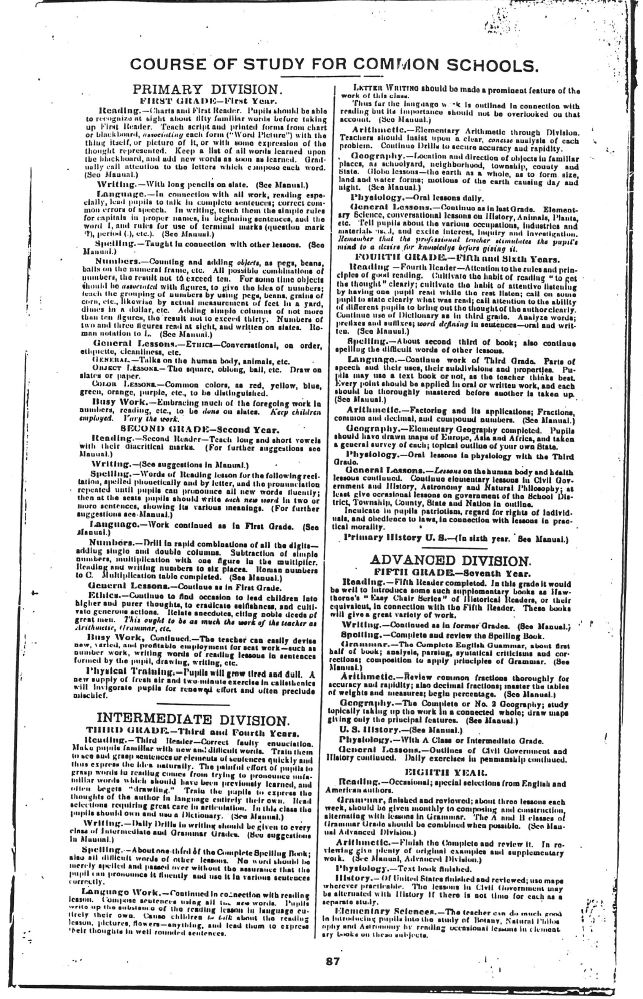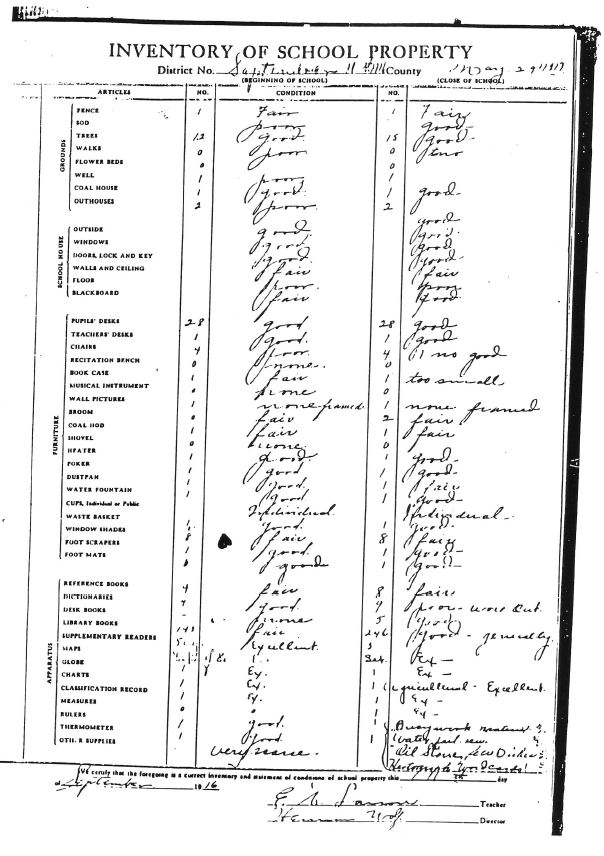Teaching In Rural Schools
by Jane Glenz
What was school like in those small, one room schoolhouses? How did a teacher manage so many children at such different ages and different levels of learning? Some of these questions are answered by teachers that were interviewed on these topics. A copy of their conversations can be found in the interview section of this chapter. But to give a general answer to these questions they managed quite well, thank you.
Classes were arranged in such a way that while the teacher was working with one group, the others had their own tasks to work on. Below is a typical schedule. This was taken from a grade book from Beversdorf School, 1917. This is the morning schedule. The afternoon was setup much the same way.
The state also prepared a manual outlining exactly what was to be taught at each grade level. A copy of the “Course of Study for Common Schools” is on the next page.
Most of the teachers that taught in these schools did not remain at the school for long. Having the same teacher for five years would be the exception rather than the rule. Because of this high turnover rate, each teacher recorded in their grade books comments about each student. The following is one of these. (Taken from Larson grade book, 1917). (Any grammar or spelling errors are theirs.)


To the successor of Jt. 1 Belle Plaine
The school has been carefully graded but due to irregular attendance some are behind in their work. Special work in review must be given people in primary reading if the class desire to remain together. As some entered school for a few weeks and others for 6 or 7 months. Look up the attendance and you will find the cause of their being backward for their classes.
Number 22 is not bright and severe patience is needed in his handling. I suggest that numbers 39, 18, 19 form a separate class. Sixth grade, as they have been absent so much, I had them recite with the 3 and 4 arith. and Geo. and in all other studies with the seventh grade.
Hold monthly examination and grade the pupils as you see fit according to their ability. I did this from the first and found numbers 17, 9, 21 not able to keep up in the 6 and 7 year reading and arithmetic. I put them back for three months and with special work, they have now joined their regular class. However, it may be necessary to put them back again. The school board has purchased an expensive and valuable chart for agricultural work. Pupils are interested in this work. Keep it up and, now hoping you may profit by this above report, I remain, with best wishes for your future . . .
ATTENDANCE
Attendance at these rural schools was very sporadic. Below is a chart that shows the attendance for one rural grade school.
Most of the absences were due to farm work or cold weather. One frustrated teacher wrote in her grade book (1919), “The most difficult problem here is to get the children to attend regular. They stay home for the least little rain or storm . . . They are absent too much for no reason.” Looking at individual attendance there were student absences, out of 173 days of school, of 107, 75, 116, 83, 88, 58, 139, etc. The fewest days absent were 21! The surprising thing, though, most of these students were promoted to the next grade.
| Month | Students Enrolled | Ave. Daily Enrolled Attend. |
| Sept. | 54 | 20 |
| Oct. | 54 | 33 |
| Nov. | 54 | 34 |
| Dec. | 50 | 37 |
| Jan. | 50 | 23 |
| Feb. | 50 | 29 |
| Mar. | 50 | 31 |
| Apr. | 50 | 36 |
| May | 50 | 36 |
Many times school was closed where contagious deceases were in the area. For example, one school was closed from October 15 to November 11 (1918) because of Spanish Influenza.
The students also had holidays off. Besides the traditional holiday vacations such as Christmas and Thanksgiving, they also had Washington’s Birthday off in February; Liberty Day on April 26th, Red Cross Day on May 17th, and Decoration Day (Memorial Day).
TESTING
In order to graduate from the eighth grade a student had to pass a test prepared by the state. These tests were given by the teacher two weeks before the close of school and then sent to the county superintendent. Below are the questions that were asked in the early 1900’s. A teacher had to use these questions, but they could add any of their own if they wished.
MATH
1. Change three fifths to denom. 15. Change to Denominator, 17.
2. Two thirds of three sixths is twice what number?
3. Change two sevenths to decimal fraction. Give rule.
4. Three fifths of a number is what per cent of it? Sold apples for three cents that cost two cents. What was rate per cent gain?
5. Define “rate percent; base; percentage. Illustrate each.
6. Sold house for $6,752.28, gaining 25%. What did I pay for the house.
7. Assume data and make bill: Bought 451 feet lumber at $18 per M., 1200 lbs. coal at $9 per ton; 80 fence posts at 6 cents each.
8. Write a negotiable note for $365.56, time one year three months, interest at 7% per annum. Get amount at maturity.
9. Divide .006 by .06; also divided .06 by 006. Give rule or principle.
10. How many acres in field 60 rods long and 35 rods wide. Get worth at $81 per acre.
11. A man owns the N.E. of S.W. of Sec. 6, Town 25, R. 18 East. How much land is this. Diagram Section and locate this piece of land.
GRAMMAR
1. Give kind of sentences as to structure. Illustrate.
2. What determines “parts of speech?” Give one illustration.
3. What is a phrase? Give and illustrate the three kinds of.
4. What is a Clause? Give and illustrate the three kinds of
5. What is a verb. Define and illustrate….transitive, intransitive.
6. Verbs: Tell what you know of mode, tense, person, number.
7. What is a pronoun? Give and illustrate classes of.
8. Abbreviations, contractions: Define and illustrate 4 of each.
9. Tell all you know as to use of capital Ietters.
10. Make and name punctuation marks. Give three rules for use of illus.
11. Write essay, one page, on Spring, to show ability to express thoughts.
READING
1. What Reading do you do outside of school? Name some of the books or papers you read or have read. Give choice, and why.
2. List of words; give meaning, and put in sentence with meaning given to show your knowledge of words as to meaning and use, and spelling. WORDS: faint, trader, merchant, manufacture, pound, tact, decree, integer, stationary, stationery, impossible, docile, fierce, angry, gay, primary, notion, pint, exact, prefer, material, refer, average, industry, concrete, abstract, sign, fine, seal, deal, conceal, brief, dictate, control, divert, dubious, barrier, guaranty, call. Take any (25 of these).
3. What do you need to know that you may get the meaning of words from the Dictionary, including pronunciation? Spelling, as well as Reading, will be marked from this paper.
GEOGRAPHY
1. Name and locate countries engaged in recent European War.
2, What and where? Detroit, LaPlata, Amazon, Gibraltar, Manila, Honolulu,
Superior, Alaska, Panama, Vesuvius, Jerusalem, Rome, Liverpool, Duluth, Siberia, Colon, Switzerland, Belgium, Petrograd,Baltic, Berlin, Quito.
3. Define terms: sphere, meridian, parallel, equator, rotation, revolution, gulf, bay, strait, peninsula, zone, climate, plateau, degree.
4. Make map of Wisconsin, one page foolscap size, fill in particulars.
5. Name great mountain systems, stating where each is.
6. Name great river systems of world, locating.
7. Locate great plateau regions of the earth.
8. Name and locate desert regions of the earth.
9. Name ten leading cities of the world, stating noted things as to them.
10. Compare the United States in all particulars with any of Europe.
*** Take the 1st and 10th and any other three.
U.S. HISTORY
1. Write briefly as to American discoveries.
2. Write briefly concerning Thirteen Colonies.
3. Give Territorial Acquisitions of U.S., stating briefly as to each.
4. Name leading Wars of U . S. —- cause, settlement.
5. Write, briefly, as to Slavery in United States.
6. State briefly, as to Constitution of United States.
7. Give Great Political issues of U.S. Define each briefly.
8. Name ten U.S. historical characters, with something of each.
*** Take any five
PHYSIOLOGY + HYGIENE
1. Define . . . Anatomy, Physiology, Hygiene
2. Define Terms: tissue, gland, organ system, bile, chyle, chyme, duct, sinew, tendon, mucous, cartilage, secretion, excretion.
3. Give five rules of health.
4. Name five food products standard ones.
5. Write concerning Stimulants and Narcotics.
6. Write concerning Home Sanitation.
EQUIPMENT
One of the biggest complaints of the teachers was a lack of materials. A list of a typical inventory is on the next page. The teachers were always quick to offer their own comments about what was needed in hopes the county superintendent would notice and make changes.

The outhouse seemed to be of great concern to the county superintendent. The following memo was sent to the teacher in 1913 and contains detailed information on just how to build an outhouse.
1. Always FACE THE OUTHOUSE to the SOUTH.
Why? . . . Because there is no reason, in Use or in Architecture why they should face any other way; and there are many Good Reasons for facing SOUTH in this climate. Our bad storms, winds, etc., come from East, North and West. Faced South you get the Sunshine and best exposure.
OUTHOUSE should be well lighted. Place windows on south side. Place windows high up, at least 5 feet.
2. Have roof slant Equally East and West; or Entirely to the North.
Why? The Doorway is to be in the South Gable, and arranging roof as directed the Drip off eave will not fall on steps where children enter. It tends to keep entrance way dry. Will it look well this way? Yes, if it serves the purpose for which an outhouse should be built. They are not built for show.
3. The FLOOR should be at least One Foot above ground level.
Why? Because, in this climate we have deep snows; and floor should be high enough so snow will not roll in on floor. Make floor with slight incline to south, or to door so that in sweeping or mopping out dirt tends toward door. Make door to swing out and against door-jams. Do not put in a threshold. A twenty-eight (28) wide doorway is wide enough. Hundreds go through Car Doors not any wider. If door or doors are placed on the South, from April 1st to Dec. 1st, they might be fastened back . . .
- Paint privy some shade of Green; or any neutral color.
- Boys’ Privy; make three seats and one stall for every three boys.
- Girl’s privy; one seat for every three girls. Seats for both boys and girls should be not over twelve inches at back and nine in front. and have hinged covers; use strap hinges.
Call at Office, if you don’t understand
